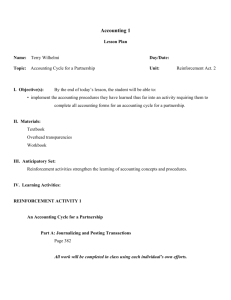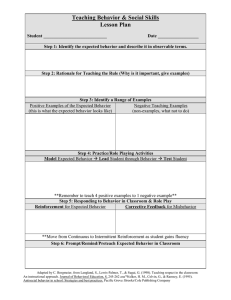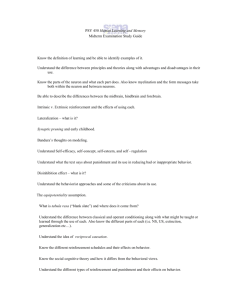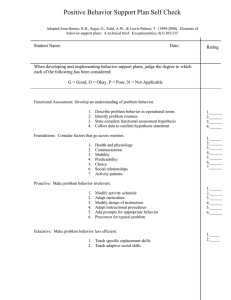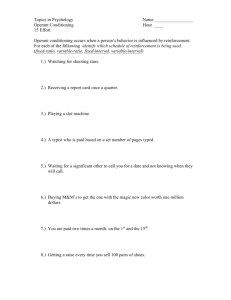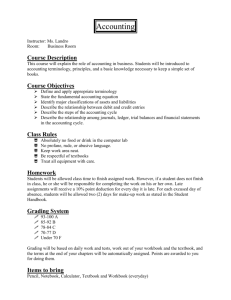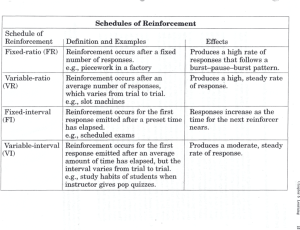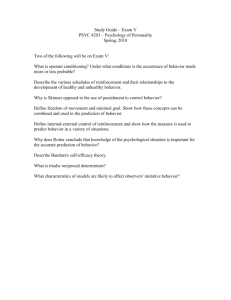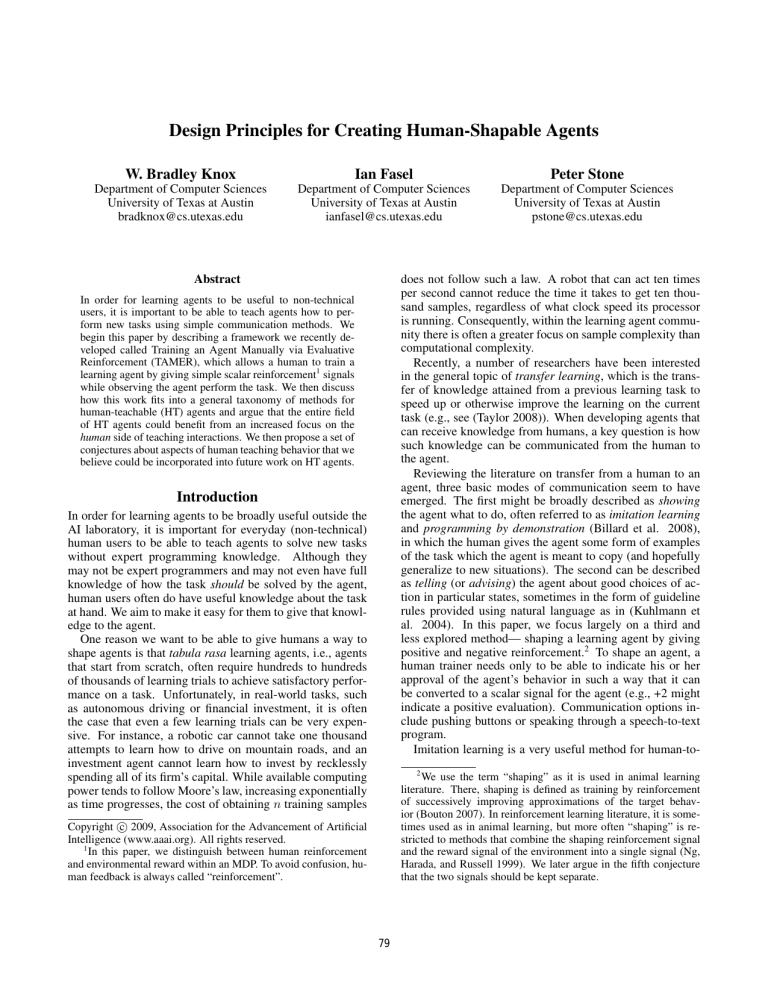
Design Principles for Creating Human-Shapable Agents
W. Bradley Knox
Ian Fasel
Peter Stone
Department of Computer Sciences
University of Texas at Austin
bradknox@cs.utexas.edu
Department of Computer Sciences
University of Texas at Austin
ianfasel@cs.utexas.edu
Department of Computer Sciences
University of Texas at Austin
pstone@cs.utexas.edu
does not follow such a law. A robot that can act ten times
per second cannot reduce the time it takes to get ten thousand samples, regardless of what clock speed its processor
is running. Consequently, within the learning agent community there is often a greater focus on sample complexity than
computational complexity.
Recently, a number of researchers have been interested
in the general topic of transfer learning, which is the transfer of knowledge attained from a previous learning task to
speed up or otherwise improve the learning on the current
task (e.g., see (Taylor 2008)). When developing agents that
can receive knowledge from humans, a key question is how
such knowledge can be communicated from the human to
the agent.
Reviewing the literature on transfer from a human to an
agent, three basic modes of communication seem to have
emerged. The first might be broadly described as showing
the agent what to do, often referred to as imitation learning
and programming by demonstration (Billard et al. 2008),
in which the human gives the agent some form of examples
of the task which the agent is meant to copy (and hopefully
generalize to new situations). The second can be described
as telling (or advising) the agent about good choices of action in particular states, sometimes in the form of guideline
rules provided using natural language as in (Kuhlmann et
al. 2004). In this paper, we focus largely on a third and
less explored method— shaping a learning agent by giving
positive and negative reinforcement.2 To shape an agent, a
human trainer needs only to be able to indicate his or her
approval of the agent’s behavior in such a way that it can
be converted to a scalar signal for the agent (e.g., +2 might
indicate a positive evaluation). Communication options include pushing buttons or speaking through a speech-to-text
program.
Imitation learning is a very useful method for human-to-
Abstract
In order for learning agents to be useful to non-technical
users, it is important to be able to teach agents how to perform new tasks using simple communication methods. We
begin this paper by describing a framework we recently developed called Training an Agent Manually via Evaluative
Reinforcement (TAMER), which allows a human to train a
learning agent by giving simple scalar reinforcement1 signals
while observing the agent perform the task. We then discuss
how this work fits into a general taxonomy of methods for
human-teachable (HT) agents and argue that the entire field
of HT agents could benefit from an increased focus on the
human side of teaching interactions. We then propose a set of
conjectures about aspects of human teaching behavior that we
believe could be incorporated into future work on HT agents.
Introduction
In order for learning agents to be broadly useful outside the
AI laboratory, it is important for everyday (non-technical)
human users to be able to teach agents to solve new tasks
without expert programming knowledge. Although they
may not be expert programmers and may not even have full
knowledge of how the task should be solved by the agent,
human users often do have useful knowledge about the task
at hand. We aim to make it easy for them to give that knowledge to the agent.
One reason we want to be able to give humans a way to
shape agents is that tabula rasa learning agents, i.e., agents
that start from scratch, often require hundreds to hundreds
of thousands of learning trials to achieve satisfactory performance on a task. Unfortunately, in real-world tasks, such
as autonomous driving or financial investment, it is often
the case that even a few learning trials can be very expensive. For instance, a robotic car cannot take one thousand
attempts to learn how to drive on mountain roads, and an
investment agent cannot learn how to invest by recklessly
spending all of its firm’s capital. While available computing
power tends to follow Moore’s law, increasing exponentially
as time progresses, the cost of obtaining n training samples
2
We use the term “shaping” as it is used in animal learning
literature. There, shaping is defined as training by reinforcement
of successively improving approximations of the target behavior (Bouton 2007). In reinforcement learning literature, it is sometimes used as in animal learning, but more often “shaping” is restricted to methods that combine the shaping reinforcement signal
and the reward signal of the environment into a single signal (Ng,
Harada, and Russell 1999). We later argue in the fifth conjecture
that the two signals should be kept separate.
c 2009, Association for the Advancement of Artificial
Copyright Intelligence (www.aaai.org). All rights reserved.
1
In this paper, we distinguish between human reinforcement
and environmental reward within an MDP. To avoid confusion, human feedback is always called “reinforcement”.
79
Table 1: Results of various Tetris agents.
Method
Mean Lines Cleared
TAMER
Human
Sensory
Display
Environment
Games
at Game 3
at Peak
for Peak
65.89
65.89
3
RRL-KBR (2004)
5
50
120
Policy Iteration (1996)
0 (random until game 100)
3183
1500
Genetic Alg. (2004)
0 (random until game 500)
586,103
3000
CE+RL (2006)
0 (random until game 100)
348,895
5000
State
Reinforcement
Action
Model
Update
Agent
Supervised
Learner
Reinforcement
Model
Reinforcement
Prediction
agent transfer, however it requires more of the trainer than
does shaping. In imitation learning, a teacher must take control of the agent and demonstrate a policy. In contrast, a
shaping trainer only needs to criticize the agent. Not everyone is an expert, but as they say, “everyone’s a critic.” Additionally, the cognitive load of giving positive and negative
evaluation is arguably less than that of remote-controlling
an agent (provided it is even possible). Agents that receive
natural language advice require an understanding of natural language, a feat thus far accomplished only in specific
domains after an extensive hand-labeling of language samples (Kuhlmann et al. 2004).
In our work on creating human-shapable agents, we developed a general framework called TAMER (for Teaching
an Agent Manually via Evaluative Reinforcement). As a
proof-of-concept, we created a specific algorithm within the
TAMER framework (Knox and Stone 2008) that allows human trainers to teach a learning agent to play Tetris, a puzzle
game. On average, the agents learned good policies an order
of magnitude faster than tabula rasa agents, clearing more
than 50 lines per game by the end of the third game (see
Table 1).
In this position paper, we first describe the TAMER
framework and a generic high-level algorithm for the framework in the following section. Then we give a review of
methods by which a human can train an agent in the section entitled “Taxonomy”. Finally, in a section called “Conjectures”, we state a number of conjectures about designing
a shapable agent. A common theme is that knowledge of
how a human delivers reward should guide the design of any
shaping algorithm. The conjectures have not been experimentally tested, but we argue for each using what evidence
is available.
Figure 1: Framework for Training an Agent Manually via Evaluative Reinforcement (TAMER) in an MDP\R.
R unspecified or removed. Following Abbeel and Ng’s terminology (Abbeel and Ng 2004), we call this specification
an MDP\R. A description of MDPs can be found in (Sutton
and Barto 1998).
A TAMER agent seeks to learn the human trainer’s reinforcement function H : S × A → R. Presented with a
state s, the agent consults its learned model Ĥ and chooses
the action a that maximizes Ĥ(s, a). Since the agent seeks
only to maximize human reinforcement, the optimal policy
is defined solely by the trainer, who could choose to train the
agent to perform any behavior that its model can represent.
When the agent’s performance is evaluated using an objective metric, we expect its performance to be limited by the
information provided by the teacher.3
A key insight of the TAMER framework is that the problem of credit assignment that is inherent in the field of reinforcement learning (Sutton and Barto 1998) is no longer
present when a human trainer, evaluating recent state-action
pairs with a model of their long-term consequences, can label those pairs within a temporal window of when they occur
(argued later in the first conjecture). Assigning credit within
that window presents a challenge to the agent, which we discuss later in the second conjecture, but it is much easier than
assigning credit for an arbitrarily delayed reward signal as in
reinforcement learning. Because a trainer can directly label
behavior, modeling the trainer’s reinforcement function H
is a supervised learning problem.
If we assume that the human trainer desires to teach a
specific policy described by H, then it is sufficient for the
agent to learn a function Ĥ that maps to H such that
Ĥ(s, a1 ) > Ĥ(s, a2 ) ⇐⇒ H(s, a1 ) > H(s, a2 ).
If this relation holds, the policies created by greedily exploiting Ĥ and H are equivalent. However, from our subjective observations, human trainers do not usually have one
specific policy that satisfies them. Rather, there is a set of
acceptable policies that are deemed “good enough”. The set
may change during the course of training (e.g., enlarging if
the trainer gets bored with the interaction, or shrinking if the
agent starts performing better than expected).
TAMER Framework
At the highest level of description, the TAMER framework
allows a human to train an agent to perform a task via positive and negative reinforcement signals. From the agent’s
point of view, its goal is to model the human’s reinforcement
while exploiting that model to earn as much immediate reinforcement as possible. A key factor is that human teachers
are treated differently from the environment in general (see
Figure 1 and the fifth conjecture). By exploiting knowledge
about human behavior, we can make learning more efficient
than if we only had access to, or treated human feedback as
just an additional source of, environmental reward.
Comparison with Reinforcement Learning The
TAMER framework for shaping agents shares much
common ground with temporal difference reinforcement
Specification and Overview
3
In principle, the agent could use both human and environmental feedback while learning. But in its initial version, TAMER focuses entirely on H.
The TAMER framework is designed to work within Markov
Decision Processes (MDPs) that have the reward function
80
learning, but there are some key differences.
In reinforcement learning, agents seek to maximize return, which is a discounted sum of all future reward. In
contrast, a TAMER agent does not seek to maximize a discounted sum of all future human reinforcement. Instead, it
attempts to directly maximize the immediate expected reinforcement given by the human trainer. It does so under the
assumption that the trainer’s reinforcement signal is a direct
label on the value of recent state-action pairs.
Correspondingly, the human’s reinforcement function H
is not an exact replacement for a reward function R within
an MDP. Although it may be possible for a reinforcement
learning algorithm to use H in lieu of a reward function, it
would be unnecessary extra computation, since H already
defines a policy. We use MDP\Rs because an environmental reward function dictates the optimal policy, so R is removed to make the human’s reinforcement function the sole
determinant of good and bad behavior from the agent’s perspective.
3. shaping the agent by rewarding actions it takes as it runs
autonomously
Advice: Advice, in the context of MDPs, is defined as suggesting an action when a certain condition is true. Maclin
and Shavlik pioneered the approach of giving advice to reinforcement learners (Maclin and Shavlik 1996). Giving
advice via natural language could be an effective way for
non-technical humans to teach agents in some cases. This
method was demonstrated by Kuhlmann et al. (Kuhlmann et
al. 2004), who created a domain-specific natural language
interface for giving advice to a reinforcement learner.
The informational richness of advice is clearly powerful,
however there still remain a number of technical challenges.
The first of these is that general natural language recognition
is unsolved, so many current advice-taking systems (Maclin
and Shavlik 1996; Moreno et al. 2004) require that the human encode her advice into a scripting or programming language, making it inaccessible to non-technical users. The
natural language unit of Kuhlmann et al. (Kuhlmann et al.
2004) required manually labeled training samples. Moreover, work still remains on how to embed advice into agents
that learn from experience.
High-Level Algorithm
A high-level algorithm for implementing TAMER is described in Algorithm 1. After some initialization steps (lines
1-4), the algorithm begins a loop that occurs once per time
step (line 5).
In the loop, the agent first obtains a scalar measurement
of the human trainer’s reinforcement since the previous time
step (line 6). If the reinforcement value is nonzero, then
the error is calculated as the difference between the actual
reinforcement and the amount predicted by the agent’s reinforcement model (denoted ReinfModel in the pseudocode;
line 8). The model, left undefined for the general TAMER
algorithm, can be instantiated in multiple ways as discussed
below. The calculated error and the most recent feature vector is then used to update the reinforcement model (line 9).
The agent then obtains the current state description (line
11) and greedily takes the action a that, according to the human reinforcement model, yields the largest predicted rein→
−
forcement (line 12). The new feature vector f is calculated
(line 13) and the chosen action is taken (line 14) before the
loop restarts.
Learning a general state-action mapping from examples:
One of the most straightforward ways to teach an agent
is simply to remote-control it using whatever interface is
most convenient to the human, while the agent records stateaction pairs (note that the recorded state variables, to be
used by the learner, may be different from the state variables
that the human operator has access to). One of the most
celebrated examples of this type of teaching is ALVINN, a
neural network based autonomous car (Pomerleau 1989), in
which a human drove a car while it recorded the steering
wheel position and camera sensors periodically. A neural
network was then trained to map camera input to a distribution over output directions, and the chosen action was the
center of mass of the output direction activations.
Many subsequent methods of teaching by demonstration
have followed a similar approach, albeit using more sophisticated methods to learn an input-output mapping. For in-
Taxonomy
Algorithm 1 RunAgent() for TAMER
Require: Input: stepSize
Work on human-teachable agents has taken many forms, all
with the aim of reducing the amount of programming required by an expert and instead allowing a human to transfer knowledge to an agent in a more natural way. As noted
by Atkeson & Schaal (1997), many works prior to the mid90s for teaching robots focused on an automatic programming process, driven by showing a robot a demonstration
of the task, segmenting it into primitive actions and relationships, and then submitting these to a symbolic reasoning
process. Bakker & Kuniyoshi (1996) give an overview of
many of these earlier approaches (most of which came from
a symbolic-AI perspective). In this paper, we focus on the
most prominent approaches since that time, which we briefly
categorize into three types:
1. advising (or simply telling) to the agent what it should do
2. demonstrating the agent examples of what it should do
1:
2:
3:
4:
5:
6:
7:
8:
9:
10:
11:
12:
13:
14:
15:
16:
81
ReinfModel.init(stepSize)
→
−
→
−
s ← 0
→
−
→
−
f ← 0
a ← −1
while true do
h ← getHumanReinfSincePreviousTimeStep()
if h = 0 then
→
−
error ← h - ReinfModel.predictReinf( f )
→
−
ReinfModel.update( f , error)
end if
→
−
s ← getStateVec()
→
a ← argmaxa (ReinfModel.predict(getFeatureVec(−
s , a)))
→
−
→
f ← getFeatureVec(−
s , a)
takeAction(a)
wait for next time step
end while
stance, Grollman & Jenkins (2007b; 2007a) and Atkeson
et al. (1997) have used methods such as locally weighted
projection regression (Vijayakumar and Schaal 2000) and
sparse online Gaussian processes (Csató and Opper 2002)
to learn this mapping.
A slightly different form of learning from human demonstrations is Apprenticeship Learning (Abbeel and Ng 2004).
In this method, the algorithm begins with an MDP\R and
a human temporarily controls the agent. Instead of learning a policy that directly mimics the human, apprenticeship
learning infers a reward function from the human-provided
examples, and then uses reinforcement learning on an MDP
consisting of a simulator (which models the state transitions)
and the learned reward function. The goal is therefore to
maximize the long-term discounted reward rather than to
make a direct input-output mapping via supervised methods.
Considering demonstrations for which a human controls
the agent, some tasks may be too difficult for a human
trainer. This might be because the agent has more actuators than can be put in a simple interface (e.g., many robots)
or because the task requires that the human be an expert before being able to control the agent (e.g., helicopter piloting
in simulation). In these cases, a demonstration is infeasible.
& Breazeal, the agent doesn’t explicitly learn to model the
human reward function, but rather uses the human reward as
a reward signal in a standard RL framework.
The TAMER system described above uses this shaping
form of communication. The goal of TAMER is to allow human instruction to be as simple as possible, eliminating the
need to create example data or use any kind of programming
(even one based on natural language). It is unnecessary for
the human trainer to give specific feedback about how bad
or good an action is or exactly what went wrong – the human must only accurately indicate when things are generally
good or bad. TAMER is distinguished from previous work
on human-delivered reward in that it is designed to work in
complex domains through function approximation.
Of particular interest is the fact that TAMER does not simply incorporate the human as part of the environment and
treat human reinforcement as additional environmental reward. Instead, TAMER forms a model of human reinforcement and uses the model for greedy action selection, thus
far reaching empirical success. The remainder of this paper
discusses design principles for developing human-shapable
agents, four of which are used in TAMER and then two more
that we would eventually like to incorporate into the system.
Shaping:
Within the context of human-teachable agents, a human
trainer shapes an agent by reinforcing successively improving approximations of the target behavior. Another name for
this method is clicker training, which comes from a form of
animal training in which an audible clicking device is previously associated with reinforcement and then used as a reinforcement signal itself to train the animal.
Most clicker training has involved teaching tricks to simulated or robot dogs. Kaplan et al. (2002) and Blumberg et al.
(2002) respectively implement clicker training on a robotic
and a simulated dog. Blumberg et al.’s system is especially
interesting, allowing the dog to learn multi-action sequences
and associate them with verbal cues. While interesting in
that they are novel techniques of teaching pose sequences to
their respective platforms, neither is evaluated using an explicit performance metric, and it remains unclear if and how
these methods can be generalized to other, possibly more
complex MDP settings.
Thomaz & Breazeal (Thomaz and Breazeal 2006) interfaced a human trainer with a table-based, Q-learning agent
in a virtual kitchen environment. Their agent seeks to maximize its discounted total reward, which for any time step
is the sum of human reinforcement and environmental reward.4
In another example of mixing human reward with ongoing reinforcement learning, Isbell et al. (Isbell et al. 2006)
enable a social software agent, Cobot, to learn to model human preferences in the virtual world LambdaMOO. Cobot
“uses reinforcement learning to proactively take action in
this complex social environment, and adapts his behavior
based on multiple sources of human reward.” Like Thomaz
Conjectures: using knowledge of human behavior to
design human-teachable agents
The TAMER system, which models human behavior, is
meant to be as simple for humans to use as possible. To
design a shaping agent, we believe that it is important to
make explicit use of knowledge about human behavior and
incorporate it into the choice and use of the model.
In this section we list and discuss a series of conjectures
about the behavior of human trainers that can serve as guidance in creating systems that use shaping feedback. These
conjectures are not meant to be taken as statements of fact,
but rather are meant to serve as hypotheses to guide our development and testing as we build more effective agents that
learn from humans.
1. Modeling the reinforcement of a human trainer
largely removes the problem of credit assignment.
Supervised learning, not temporal difference
learning, is therefore the correct approach.
In a typical Markov Decision Process, reward is given
sparsely. A canonical example is a checkers game in which
the reward signal is 0 until the end of the game (Mitchell
1997). In these MDPs, temporal difference learning and
similar reinforcement learning approaches are used to infer
the value (in terms of expected return) of non-reward states
(or state-action pairs) given only this very sparse feedback.
We conjecture that a human that trains an agent in an
MDP\R does not pose as challenging of a credit assignment
problem. In particular, we suppose that the trainer’s feedback reflects (in some way) their internal beliefs about the
long-term effects of actions, and therefore human feedback
is more closely related to the long-term value5 of actions
4
As indicated in footnote 2, combining human reinforcement
and environmental reward into one reward signal is the narrower
definition of shaping in reinforcement learning.
5
“Value” is used here in the general sense of the word. We are
not claiming that the human’s mind contains a numerical repre-
82
there is a zero credit region from 0 seconds to 0.3 seconds,
which represents the minimum delay of human response for
this kind of task.
Therefore, we propose using a gamma distribution function to choose weights for credit assignment when using a
human teacher in relatively fast, continually running tasks.
Because we do not know the exact time since the event being responded to, we propose assigning credit based on how
likely the human reward was given in response to each previous time step (illustrated in Figure 2). Specifically, let
time 0 be when a reinforcement h is given. For a single
time step that occurred t seconds before reinforcement and
the time step immediately before it, occurringt before reint
forcement, credit for the time step at t is h × t f (x)dx.
In Algorithm 2, an
extension of Algorithm
1 with credit assignment added, we show
a method for applying credit in incremental updates of a linear
model.7 Specifically,
credit takes the form
of a weight credit between zero and one
on the step size parameter α. Provided
we have a way to use
credit weights, we now
are left with a question
of what credit weighting function is best for
making use of human
reward signals.
Differences in individual response times,
Figure
3:
Hockley’s
the complexity of the
study (Hockley 1984) of the
task, and other facdistribution of human’s negative
response times to visual searches
tors will likely affect
of different levels of complexity.
the actual distribution
of responses in any one
training episode. One idea for an appropriate calibration is
to perform a Bayesian update using response time data from
the trainer while he or she performs a visual search task.
The prior would be a distribution over the parameters of the
Gamma distribution that is denser near the parameters we
used to roughly approximate Hockley’s results, and the likelihood would be calculated from the trainer’s samples.
Figure 2: Probability density function f (x) for a gamma(2.0,
0.28) distribution. Reinforcement signal h is received at time 0.
If t and t are times
R t of consecutive time steps, credit for the time
step at t is h × t f (x)dx.
rather than the immediate goodness of actions. For instance,
a human trainer may give negative feedback about a particular checkers move because the trainer knows that it will
ultimately lead to poor results, even if it does no immediate
harm in terms of number of pieces on the board.
Therefore we propose that a human trainer’s reinforcement signal should be considered a label of the overall value
of the recent state-action trajectory, and therefore it does not
carry the full credit assignment problem that a traditional
MDPs reward signal does. There is still some ambiguity in
how to temporally assign credit, but we believe this problem is much simpler (as we explain in the next conjecture).
Our positive results from applying TAMER to Tetris seem
to support this first conjecture.
2. Assignment of credit from reinforcement by a
human trainer should be similar to the Gamma
probability density function shown in Figure 2.
Some task domains, such as Tetris, can occur at a rate of
one action (i.e., a piece placement) per two seconds, or
slower, without seeming unnatural. In such domains, a human trainer can easily give feedback to individual actions
in the time between time steps. However, many interesting
domains require actions at a much faster rate. Tasks that require visually fluid motion are examples of this faster class
of domains. For such domains, the human trainer cannot accurately label individual state-action pairs in real time, and
so a credit assignment scheme that distributes the reinforcement across recent time steps is required.
The psychology literature contains quite a large number
of studies of human reaction time for decision making. An
important one is William Hockley’s study of the time required for a human subject to make a judgment about n
items (requiring a visual search) and push a button to communicate their decision (Hockley 1984). Reacting during a
visual search task is similar to the task that a human trainer
confronts — watching behavior and evaluating it. Histogram
results of Hockley’s reaction time study are shown in Figure 3. As shown in Figure 2, a gamma distribution can be
used to effectively approximate these histograms.6 Note that
3. A human trainer’s reinforcement function is a
moving target.
Though much research has been done on how animals are
best shaped (Ramirez 1999), relatively little work has examined the trainer and how he or she delivers reinforcement.
However, consider this example. Imagine training a dog
to jump and touch a colored circle on a wall. At first you
sentation of the discounted sum of expected reward, as “value” is
defined in reinforcement learning.
6
Another good candidate is the lognormal distribution.
7
A detailed explanation of this algorithm can be found at
www.cs.utexas.edu/users/bradknox/papers/linearTAMER.pdf.
83
Algorithm 2 RunAgent() for TAMER with credit assignment us-
time progresses, Cobot is receiving less feedback... despite
the fact that Cobot is learning [preferential] policies.”
Therefore the designer of a system that allows human
trainers to shape learning agents should choose a supervised learning algorithm that performs well with moving
target functions. Certain recency-weighted function approximation algorithms used in temporal difference learning are
thus good candidates and have been effective in recent work
(Knox and Stone 2008). Examples of such algorithms include gradient descent over the weights of a linear model
(which we use) and backpropagation in a multi-layer neural
network.
ing a linear model
Require: Input: stepSize, windowSize,
1: ReinfModel.init(stepSize)
2: Crediter.init(windowSize)
→
−
→
3: −
s ← 0
→
−
→
−
4: f ← 0
5: a ← −1
6: while true do
7:
Crediter.updateTime(clockTime())
8:
h ← getHumanReinfSincePreviousTimeStep()
9:
if h = 0 then
−−−−−−−→
10:
credF eats ← 0
→
−
11:
for all ( ft , t) ∈ Crediter.historyWindow do
12:
credit ← Crediter.assignCredit(t)
−−−−−−−→
−−−−−−−→
→
−
13:
credF eats ← credF eats + (credit × ft )
14:
end for
−−−−−−−→
15:
error ← h − ReinfModel.predict(credF eats)
−−−−−−−→
16:
ReinfModel.update(credF eats, error)
17:
end if
→
−
18:
s ← getStateVec()
→
19:
a ← argmaxa (ReinfModel.predict(getFeatureVec(−
s , a)))
→
−
→
20:
f ← getFeatureVec(−
s , a)
21:
takeAction(a)
→
−
22:
Crediter.updateWindow( f )
23:
wait for next time step
24: end while
4. Shaping reinforcement from a human trainer
provides feedback on state-action pairs or
state-next state pairs, not on state alone.
For most types of reinforcement learning agents, the programmer must decide whether the agent will learn a statevalue function, V : S → R, or a state-action-value function,
Q : S × A → R. Though in this context “value” means a
discounted sum of expected future reward, a designer of a
human-shapable agent might wonder whether to model the
trainer’s reinforcement as a function of the state alone or the
state-action pair.
In our work on TAMER, we found that modeling the reinforcement function by state alone, H : S → R, is ineffective, producing no appreciable learning. Modeling by
state-action pair, H : S × A → R, works well. Additionally, modeling by state-next state pair, H : S × S → R,
may also be effective. The Tetris TAMER agent modeled a
similar function with good results.
Considering the task of the trainer, this result is not surprising for MDPs that have a much larger state space than
action space (as most commonly used MDPs do). For expository purposes, assume that the trainer has exactly one
policy in mind that he or she wants to teach the agent to follow. Say the agent is modeling the human’s reinforcement
as a function of only state. To communicate the desired policy, the trainer must give reinforcement such that the model
yields the correct preference ordering over all states. For
even relatively small state spaces, ordering them correctly
would be extremely difficult. Now say the agent is modeling a function of state-action pairs. Then, for any given
state, the trainer merely has to give reinforcement such that
the best action has the highest expected reinforcement.
Another disadvantage of modeling the trainer’s reinforcement as a function of the state is that the agent would need
a model of the transition function, H : S × A × S → R,
to choose a next state. Learning a transition function is a
challenging problem and an active area of research.
might reinforce him for merely approaching the wall. Once
the dog reliably does that, you would raise your standards,
giving fewer and less emphatic rewards for approaching the
wall and saving larger rewards for touching the wall. As the
dog learns to touch the wall, you raise the standards again,
making the dog touch higher on the wall. As a trainer, you
would raise the standards for reinforcement as performance
increases until the target behavior has been learned.
Using the sensible principle that teaching methods generally fit learning methods, we conjecture that as animals can
be shaped by rewarding successive approximations of goal
behavior (Bouton 2007), humans will naturally reward accordingly. Rewarding successive approximations means that
the level of performance needed to receive a certain amount
of reward increases as the performance increases. Improvement is rewarded, not absolute quality of performance. We
do not punish a bright 5th grade math student for not knowing calculus, and we do not constantly reward a high school
senior for knowing long division. Humans positively reinforce improvement. We negatively reinforce declines in performance. Thus the “reinforcement function” of the teacher
changes as the agent learns and improves.
Though the authors are unaware of this conjecture previously being studied directly, the previously mentioned research on the social agent Cobot (Isbell et al. 2006) did
find that a human reinforcement function is a moving target within their domain. Isbell et al. chose to mix both
explicit training rewards with implicit rewards (e.g., from
hugs) and run a reinforcement learning algorithm to learn socially adaptive behavior. They found that human reinforcement was a moving target. They report: “In all cases, as
5. If the environment is an MDP, a
human-shapable agent should treat the human
trainer differently from the rest of the
environment.
How to formally include the reinforcement signal from a human trainer in a description of the agent’s environment is an
open question. If the environment without the human trainer
84
is a Markov Decision Process, there are a few apparently attractive choices. The human’s reinforcement could be added
directly to the environmental reward to give the agent one reward signal per time step (corresponding to the narrower reinforcement learning definition of “shaping”). Alternatively,
the human’s reinforcement could replace the environmental
reward signal. In this case, the agent’s direct goal changes
to maximizing the long-term reinforcement given by the human. Assuming that the human trainer’s desired policy is
similar to the the optimal policy described by the removed
environmental reward, the agent’s learned policy should still
perform well when measured by how much environmental
reward it would be receiving (Knox and Stone 2008). A
third alternative is to add the human reinforcement signal as
a separate component to the MDP specification, which we
denote as M DP + H.
The first two options, both of which involve making
the human reinforcement signal part of the the MDP, are
technically incorrect for two reasons. The first is that a
human trainer’s reinforcement does not have the Markovian property. As discussed in the second conjecture,
there is typically some delay between an action or series of actions and an associated reinforcement by a human. Specifically, that means P (H |St , At ) does not equal
P (H |St , At , St−1 , At−1 , ...., Sn , An ). Secondly, in the
second conjecture we argue that a human’s reinforcement
function is a moving target. It therefore cannot be part of a
static MDP specification. (If an MDP specification changes,
it is a different MDP.)8
In addition to these two technical challenges, there is a
more fundamental reason not to consider the human reward
as a part of or a replacement for the environmental reward.
The first alternative, adding the human’s reinforcement and
the environmental reward to create one reward signal, destroys information by putting two fundamentally different
feedback signals together. When taken alone, the human reinforcement signal sidesteps the credit assignment problem
and can be treated as direct policy guidance (first conjecture). However when mixed with the environmental reward,
this advantageous property is lost. Mixing the two signals
also leaves open the question of how large the human reinforcement signal should be compared to the environmental
reward signal. Adequately addressing this question would
require either extensive tuning for each domain (and likely
each trainer), or it would require that the trainer understand
the environmental reward function, making it inaccessible
to trainers without relevant technical expertise. The second
option, treating the human reinforcement as if it is environ-
mental reward, also ignores useful properties of human reinforcement that are not shared by an environmental reward
signal.
When implemented on an MDP, TAMER currently follows the third alternative, creating an M DP + H. This
specification allows an agent to use both the environmental
reward and the human reinforcement separately, appreciating their unique properties. For example, while modeling H
as a form of action guidance, the learner could simultaneously do temporal difference learning with R. TAMER does
not, however, take advantage of the information given by
the environmental reward function of the MDP, only learning from human reinforcement.
6. Human trainers reinforce expected action as
well as recent action.
Human trainers maintain their own model of the agent’s policy. We conjecture that, given the chance, trainers will exploit that policy model and reinforce both what the agent has
done recently and what they expect the agent to do in the
near future. Only the former is traditionally acknowledged
by the agent community as the subject of reinforcement. The
latter, though in the future, can be considered reinforcement
of what the trainer believes to be the intention of the agent.
In an animal, intention could be considered a kind of hidden
state. Likewise, an agent could maintain a planned trajectory as hidden state. (Interestingly, this hidden state makes
the task of training look like a POMDP from the perspective
of the trainer being the agent and the trainee being part of
the environment.)
Though we have attained positive results by applying the
reinforcement only to past actions, we expect that an agent
that takes advantage of both types of reinforcement will
show increased performance.
To illustrate what is meant by reinforcing future state,
imagine a dog owner sees her dog staring at a cupcake placed
nearby. The owner will likely shout, “No!”, despite the
owner not actually having any problems with where the dog
looks. Instead, the owner is sending a strong negative reinforcer to what she infers as the dog’s intention of eating the
cupcake, which might be considered a part of the dog’s inner, hidden state. Though one might argue that the owner’s
reprimand was a form of advice, that would trivialize the
negative reinforcing power of the yell, which would make
the dog less likely to stare at the cupcake or to eat the cupcake. Advice by nature is less forceful, merely letting the
dog know what the owner recommends.
In a 1951 study of the patterns of bird movement, ethologist A. Daanje defines “intention movements” as “fragmentary or incipient movements” that reveal what the animal
intends to do (Daanje 1951). The dog’s orienting towards
the nearby cupcake would likely be considered an intention movement. From our perspective as learning agents
researchers, intention movements reveal otherwise hidden
state of a physical agent.
It is easy to see how such future-oriented reinforcement
would be useful for a learning agent. As an example, if an
agent is walking towards the edge of a cliff, repeatedly sending signals of negative reinforcement should communicate
8
Adapting the first two options from MDPs to POMDPs does
not restore the Markovian property. Accurately specifying the human’s reinforcement signal as part of a P OM DP or P OM DP +
H is unfeasible. Specifying a POMDP requires knowledge of some
underlying, partially observable states that maintain the Markovian
property. It seems to us to be an insurmountable problem to accurately specify the underlying state that predicts (even stochastically) the human choice to give reinforcement and the delay in the
trainer’s response. This state would probably include descriptions
of the human’s attention, thought processes, and other vague and
difficult to specify factors.
85
to the agent that its apparent intention is bad. The learning agent should not merely be assigning the reinforcement
to past steps towards the cliff and require falling off before
learning to avoid it. Rather, it should stop walking towards
the cliff.
Thomaz & Breazeal came to a similar conclusion in their
observations of how human trainers gave reinforcement to
an agent in a kitchen setting (Thomaz and Breazeal 2006).
Allowing trainers to give object-specific rewards (clicking
on an object and giving the reward), they found that when
the agent faced empty bowl or tray objects on a shelf, 15
of 18 subjects gave positive reinforcement specific to those
objects, even though the objects had never been previously
manipulated by the agent. From this test case and interviews
with the trainers, they concluded that many humans gave
“rewards for actions the agent was about to do in addition to
the traditional rewards for what the agent had just done.”
An agent that performs planning and somehow communicates aspects of its planned trajectory could be greatly benefited by allowing its intentions to be reinforced as well as
its recent actions. However, challenges remain in any implementation. Chiefly, there is no obvious strategy for dividing
credit between future and past actions. The answer may lie
instead in cues from the trainer that indicate whether he is
reinforcing past or intended actions.
Atkeson, C. G.; Y, A. W. M.; and Z, S. S. 1997. Locally weighted learning for
control. Artificial Intelligence Review 11:75–113.
Bertsekas, D., and Tsitsiklis, J. 1996. Neuro-Dynamic Programming. Athena Scientific.
Billard, A.; Calinon, S.; Dillmann, R.; and Schaal, S. 2008. Robot programming
by demonstration. In Siciliano, B., and Khatib, O., eds., Handbook of Robotics.
Springer. In press.
Blumberg, B.; Downie, M.; Ivanov, Y.; Berlin, M.; Johnson, M.; and Tomlinson, B.
2002. Integrated learning for interactive synthetic characters. SIGGRAPH 2002.
Bohm, N.; Kokai, G.; and Mandl, S. 2004. Evolving a heuristic function for the
game of Tetris. Proc. Lernen, Wissensentdeckung und Adaptivitat LWA.
Bouton, M. 2007. Learning and Behavior: A Contemporary Synthesis. Sinauer
Associates.
Csató, L., and Opper, M. 2002. Sparse online gaussian processes. Neural Computation.
Daanje, A. 1951. On locomotory movements in birds and the intention movements
derived from them. Behaviour 3.
Grollman, D. H., and Jenkins, O. C. 2007a. Learning robot soccer from demonstration: Ball grasping. In Robotics: Science and Systems - Robot Manipulation:
Sensing and Adapting to the Real World.
Grollman, D., and Jenkins, O. 2007b. Dogged learning for robots. ICRA 2007.
Hockley, W. E. 1984. Analysis of response time distributions in the study of cognitive processes. Journal of experimental psychology. Learning, memory, and cognition 10.
Isbell, C.; Kearns, M.; Singh, S.; Shelton, C.; Stone, P.; and Kormann, D. 2006.
Cobot in LambdaMOO: An Adaptive Social Statistics Agent. AAMAS 2006.
Kaplan, F.; Oudeyer, P.; Kubinyi, E.; and Miklósi, A. 2002. Robotic clicker training.
Robotics and Autonomous Systems 38(3-4).
Conclusion and Future Work
We have presented a general framework, called Training an
Agent Manually via Evaluative Reinforcement (TAMER),
for creating learning agents that can be shaped by human reinforcement, and we have given an overview of three communication methods — advice, demonstration, and shaping — used to transfer knowledge to human-teachable (HT)
agents. Shaping, we argue, provides an effective, accessible method of transferring human domain knowledge to an
agent, while requiring less expertise on the part of the trainer
than other HT methods. We then proposed six conjectures to
guide the creation of human-shapable agents. The first four
of these conjectures are embodied in the TAMER framework.
In future work, we will address some of the many open
questions concerning how best to learn from human reinforcement. One question is how to harness human reinforcement for actions that the trainer expects the agent to take. We
also plan to explore different methods of learning from both
environmental reward and human reinforcement, allowing
an agent to learn both with the human’s feedback and in its
absence. Most importantly, we will continue to implement
TAMER on new domains, including robotic tasks, and to test
its strengths and limits.
Knox, W. B., and Stone, P. 2008. TAMER: Training an Agent Manually via Evaluative Reinforcement. In IEEE 7th International Conference on Development and
Learning.
Kuhlmann, G.; Stone, P.; Mooney, R.; and Shavlik, J. 2004. Guiding a reinforcement
learner with natural language advice: Initial results in RoboCup soccer. AAAI-2004
Workshop on Supervisory Control of Learning and Adaptive Systems.
Maclin, R., and Shavlik, J. W. 1996. Creating advice-taking reinforcement learners.
Machine Learning 22:251–282.
Mitchell, T. M. 1997. Machine Learning. McGraw Hill.
Moreno, D.; Regueiro, C.; Iglesias, R.; and Barro, S. 2004. Using prior knowledge
to improve reinforcement learning in mobile robotics. Proc. Towards Autonomous
Robotics Systems. Univ. of Essex, UK.
Ng, A.; Harada, D.; and Russell, S. 1999. Policy invariance under reward transformations: Theory and application to reward shaping. ICML 1999.
Pomerleau, D. 1989. ALVINN: An autonomous land vehicle in a neural network.
In Advances in Neural Information Processing Systems 1. Morgan Kaufmann.
Ramirez, K. 1999. Animal training : successful animal management through positive reinforcement. Chicago, IL : Shedd Aquarium.
Ramon, J., and Driessens, K. 2004. On the numeric stability of gaussian processes
regression for relational reinforcement learning. ICML-2004 Workshop on Relational Reinforcement Learning 10–14.
Sutton, R., and Barto, A. 1998. Reinforcement Learning: An Introduction. MIT
Press.
Szita, I., and Lorincz, A. 2006. Learning Tetris Using the Noisy Cross-Entropy
Method. Neural Computation 18(12).
Acknowledgments
Taylor, M. E. 2008. Autonomous Inter-Task Transfer in Reinforcement Learning
Domains. Ph.D. Dissertation, Department of Computer Sciences, The University of
Texas at Austin.
We wish to thank Professor Michael Domjan for helpful discussions on animal learning. This research is partially supported by the DARPA Bootstrap Learning program and by
an NSF Graduate Research Fellowship to the first author.
Thomaz, A., and Breazeal, C. 2006. Reinforcement Learning with Human Teachers:
Evidence of Feedback and Guidance with Implications for Learning Performance.
AAAI 2006.
References
Vijayakumar, S., and Schaal, S. 2000. Locally weighted projection regression : An
o(n) algorithm for incremental real time learning in high dimensional space. ICML
2000.
Abbeel, P., and Ng, A. 2004. Apprenticeship learning via inverse reinforcement
learning. ICML 2004.
86


